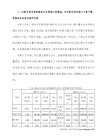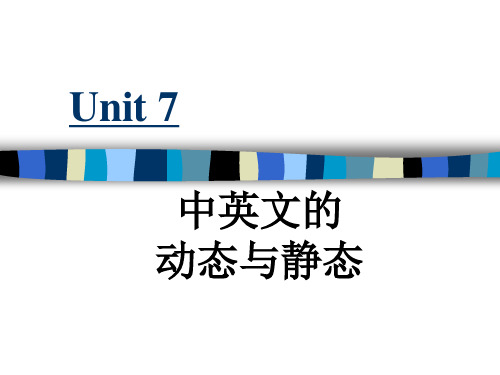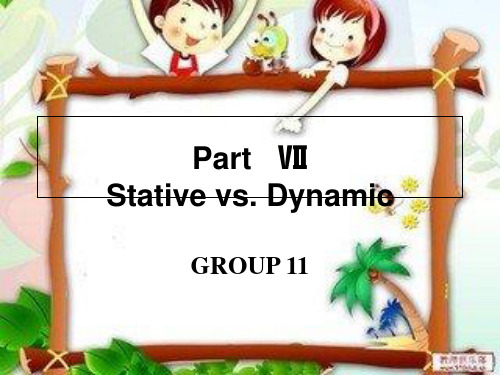第7章静态与动态(英汉对比研究)
英汉对比研究(7)

3. 副词表达动词的意义 1)I’m afraid Mr. Brown is out, but he’ll be in soon. 2) He’ll be home in half an hour. 3) Down with the old and up with the new
汉语的动态倾向
一、动词连用是汉语常见的现象 二、动词(词组)可以充当汉语句子的各种成 分 三、汉语动词常常重复或重叠
用名词作定语,其意义和功能有时相当于用 形容词作定语: race hatred=racial hatred launch pad=launching pad 然而不能以此内推,有时用名词作定语与形 容词作定语在意义和功能方面并不相同。 economy measure economic measure bankruptcy lawyer bankrupt businessman
静态与动态
英语倾向于多用名词表示动作\ 行为,因而叙述呈静态(static); 汉语倾向于多用动词来表示,因而 叙述呈动态(dynamic)。
More example: 1他支持葡萄牙占据果阿,使得亚洲人民更加反对 他的政府。 — His support for Portugal’s occupation of Goa has turned the Asian people against his government all the more. 2 他疲惫不堪,天气也越来越热,于是他下决心一 碰到舒适的阴凉处就坐下休息。 — His weariness and increasing heat determined him to sit down in the first convenient shade.
英汉对比静态与动态

5.静态-ADJ&ADV.IN PLACE OF VERBS
❖使用动词的同源形容词与弱化动词相结合的方式表达动词的意义
英汉语言对比 静态与动态
英语—静OR动?
1. Admittance Free 免票入场
2. Out of Bounds 游客止步
3. No Admittance Except on Business 闲人免进
4. Danger of Death – High Voltage! 高压危险!
英语-静态STATIVE
3.静态-PREPARATION- PROMINENT
❖ 英语常用介词短语代替动词短语,即“以静代动”
1)他们立刻出动去追击敌人。 They immediately set out in pursuit of the enemy. 2)有人给他撑腰。 He has someone behind him. 3)他在读书。 He is at his books. 4)机器正在运行。 The machine is in operation 5) 说完这些话,她便走开了。 With these words, she went away.
4.静态- VERB- WEAKEN
❖动词虚化: 把动词转化或派生成名词,置于虚化动词(have, make, take, do)之后做其宾语,如have a look, take a walk, make attempts, pay visits, do some damages, put up a proposal
英汉对比研究 静态与动态

一算 试了一试 A着A着(A了A了):看着看着 走着走着 老了老
•
了 完了完了 AABB式:说说笑笑 来来往往 吃吃喝喝 摇摇
•
晃晃 吵吵闹闹 ABAB式:讨论讨论 学习学习 休息休息 热闹
•
热闹 走动走动 ABAC式:无依无靠 有始有终 任劳任怨 没完
•
没了 敢作敢为
汉语还有大量对偶复意的动词词组,如:
静态与动态 禅茶一味 道在其中 Static vs.Dynamic
走开! Stay away! 别管我! Leave me alone! 他吃素,不吃荤 He is a vegetarian.
她们飞上了蓝天(报纸标题) Women Pilots in China 周阿斗寻父记(文章标题) A Reunion of Father and Son 你老是看钟等着下课啊! Oh! You're a clock-watcher!
佛罗里达东海岸有一场热带风暴。
A tropical storm lashed the east coast of Florida.
一场热带风暴袭击了佛罗里达东海岸。
It was the finding of the committee that
there had been bribes paid by company manager
He is at his books.(=He is reading books)
He has someone behind him. (=Someone supports him)
The machine is in operartion. (=The machine is working.)
Is this train for Chicago? (=Is this train going to Chicago?)
读书报告---《英汉对比研究》

读书报告- -《英汉对比研究》第一章:综合语与分析语本章主要是关于综合语与分析语,在文章开头作者就介绍了综合语和分析语的特征,以及它们的定义。
此外,作者通过形态变化、词序、虚词和语调声调方面对英语和汉语进行了对比研究。
首先,英语有形态变化,而汉语则没有严格意义的形态变化。
形态变化主要体现在构词形态和构形形态上。
在构词方面,英语的词缀灵活多变,有大量的前缀、后缀,而汉语则不多见。
在构形方面,英语常常是将动词、助动词和情态动词结合起来表示时态、语态和语气的变化,而汉语同一个词就可以表示主格、宾格,单数、复数,或者现在、过去等行为。
其次,英语词序较灵活,汉语则较固定。
英语词序倒置的现象比较多,汉语主要表现为功能性倒装。
汉语的定语一般在名词前,英语定语位置较灵活。
再次,虚词方面,英语经常使用定冠词、不定冠词、介词和连接词,汉语则没有冠词,表并列和从属关系的连接词的使用率也较低,较常使用的是丰富多彩的助词,如动态助词、语气助词等。
最后,英语是语调语言,汉语是声调语言。
语调和重音的变化是英语语音的主要表意手段,两者的密切配合可以表达意义的差别,而汉语的语音手段主要是声调。
汉语语音音节匀称,具有均衡美和节奏美。
第二章聚集与流散本章主要是关于英汉句式句型的对比研究。
英语句子主次分明,层次清楚,有严谨的主谓结构,句型重形合,句式为“聚集型”,而汉语则不受形态的约束,没有主谓协调一致的关系,具有多样性、复杂性和灵活性,句型重意合,句式呈“流散型”。
英语的主谓结构有五种基本句型,即SV, SVP,SVO,SV oO,SVOC,而上述句型和变式可以通过增加修饰语,扩展基本句型的成分,基本句型的组合、省略、倒装等方式来扩展。
英语注重句子结构完整,通过形态标志、连接词和填补词的使用来保持其完整性。
此外,句子成分、词语之间必须在人称、数、性和意义等方面保持协调一致的关系也是英语句子呈“聚集型”的重要因素。
然而,汉语的主谓结构则要比英语复杂的多。
英汉静态与动态对比

英语中,名词化是一种常见的语言现象
英语名词化简单说来即英语偏重使用名词,即所谓“名词 优势于动词”(preponderance of nouns over verbs) 。 英语趋向于用名词来表达原来属于动词 (或形容词) 所表 达的概念。
She succeeded in this match , so she felt encouraged (这次比赛她获胜了,因而很受鼓舞) . 从英语修辞效果上看,它更多是用以下简单句结 构表达: Her success in this match served as great encouragement to her.
他对总统声明为保持其职位而决心奋斗表示钦佩。
英汉对比之静态与动态(Static vs Dynamic)
在汉语里,动词使用频率高,呈现一种动态特征。 而在英语里,名词和介词使用频率高,呈现一种静态。
从语法上看, 英语句子是以动词为中心的。但动词的 使用频率明显低于汉语句子。周志培对三个翻译材料 (邓小平《在武昌、深圳、珠海、上海等地的谈话要 点》及英译文、英国首相撒切尔夫人在中国欢迎宴会 上的讲话及汉译文、美国罗斯福总统第四任就职演说 及汉译文) 进行分析,得出结论: 英语动词在这三个 材料中所占比率分别为14 %、11 %和15 % , 而汉语 动词所占的比率为则33 %、24 %和25 %。
In terms of economic strength India is far behind.
英语在表示方位或状态的时经常使用out﹑on﹑ over﹑ off ﹑back﹑ up ﹑apart 等副词,而汉语在表示这些状态时往往会 使用动词。所以,汉语一些表示方向或方位的状态动词要转译为 英语的副词。例: 这两个工厂相隔两公里。
汉英静态与动态比较

A tropical storm lashed the east coast of Florida. 一场热带风暴袭击了佛罗里达东海岸。 除了be之外,have, become,grow, feel, go, come, get, do等也是英语常用的弱式动词
4. 名词优势造成介词优势
介词前置于名词或名词性短语,由于英语多用名词,必然也要多用介词,所以产生了介词 优势。介词优势和名词优势的结合,使英语的静态倾向更为显著。
英语常用介词短语取代动词短语,即以“静”代“动” 如: He is at his books.(He is reading books.)
英语里表示心理或心理感觉的形容词以及其他形容词也常常与弱式动词构成系表结构,表 达相当于动词的意义。
A postman is not afraid of dogs. He was unawwre of my presence. John seems content just to sit in front of the television all night.
说是的说是,说非的说非,莫衷一是。 Some say "yes"and others "no"; I don't know whom to follow.
学问,学问,要学要问;边学边问,才有学问。 Acquisition of knowledge entails learning and seeking for explanation.
“名词+介词”的优势常见于英语里大量的弱式短语。这类短语往往削弱或淡化(dilute)原来 所要表达的动词、形容词和其他词语的意义,使叙述曲折迂回(circumlocution),所以增 强了静态感
英汉对比研究-静态与动态

静态与动态 Static vs. Dynamic
What is metaphor? any figurative expression:the transferred sense of a physical word; (词义的转移,如用 “诞生”表示任何事物的起源) the personification of an abstraction;(抽象行为的拟人化,如 “modesty forbids me”的意思是“由于谦虚,我不能”) the applicaton of a word or collocation to what it does not literally denote, i.e., to describe one thing in terms of another.( 用一个单词 或语句表示字面意思之外的意思,如用“cold blood”表示“without feeling or pi purpose of metaphor is basically twofold: referential purpose is to describe a mental process or state, a concept, a person, an object, a quality or an action more comprehensively and concisely than is possible in literal or physical language; pragmatic purpose is to appeal to the senses, to interest, to clarify 'graphically', to please, to delight, to surprise.
汉英语言对比之静态与动态

汉英语言对比之静态与动态集团文件版本号:(M928-T898-M248-WU2669-I2896-DQ586-M1988)汉英语言对比——静态与动态 (Stative vs.Dynamic)比较是人类认识世界的重要方法,也是语言研究的基本方法之一。
中国语言学大师赵元任先生说:“所谓语言学理论,实际上就是语言的比较,就是世界各民族综合比较研究得出的科学结论。
”语言研究中的比较,可以是在同一种语言内部进行的,也可以是在不同的语言之间开展的;可以是历时的,也可以是共时的。
我们这学期开设的汉英语言对比课程,我认为是在不同语言中进行的共时研究。
这门课的开设有很重要的意义,因为我们一般接触的课程里都是比较基础性的课程,比如精读,泛读,听力,口语,这些科目培养的是我们某一个具体方面的能力,这让英语的的确确变成了一门“工具型”学科,而没有展现出它作为一门语言独特的魅力。
而英汉语言对比却使我得以站在一个高度,好好的审视“英语艺术”。
英汉语言可对比之处有很多,我所写的论文研究的是静态与动态(Stative vs.Dynamic)。
英语是静态的语言,主要体现在有少用动词而用其他手段表示动作意义的倾向,倾向于多用名词,形容词,副词,介词,因而叙述呈静态(stative);汉语是动态的语言,主要体现在汉语有一种多用动词的习惯,因而叙述呈动态(dynamic)。
造成英语呈静态的原因是英语句子中的谓语动词要受很多形态变化规则的约束,使用时有很多不便, 所以一般每个句子只有一个谓语动词。
而对动词的需要有不至于此,于是只能采取名词化的方法。
也就是说英语是屈折语,英语动词的使用受到形态规则的严格限制,一个句子结构通常只用一个谓语动词,或者至多是几个动词并列作谓语。
大量原来应该用动词表达的概念除了用非谓语动词表达外,必须借助于动词以外的词类,其中主要是名词和介词,以及形容词和副词,名词和形容词等可以由动词派生或转化而来。
这种使用优势不仅降低了动词出现的频率,而且削弱了动词所表达的意义,产生了动词的虚化和弱化,这就使得英语的表达呈现“静态”倾向。
《英汉对比研究》第7章 静态与动态

第七章静态与动态(Stative vs.Dynamic)英语倾向于多用名词,因而叙述呈静态(stative);汉语倾向于多用动词,因而叙述呈动态(dynamic)。
R.Quirk等人对静态和动态曾作如下解释:Broadly speaking, nouns can be characterized naturally as ‘stative’in that they refer to entities that are regarded as stable.whether these are concrete (physical) like house,table,paper,or abstract (of the mind)like hope,botany,length.At the opposite pole,verbs can be equally naturally characterized as ‘dynamic’:they are fitted (by their capacity to show tense and aspect,for example) to indicate action,activity and temporary or changing conditions.These relations between the open classes can be summarized thus:STA TIVE noun ↔ adjectiveDYNAMIC verb adverb英语的静态倾向,主要表现在以下几方面:一、名词化(Nominalization)是英语常见的现象。
名词化主要指用名词来表达原来属于动词(或形容词)所表达的概念,如用抽象名词来表达动作、行为、变化、状态、品质、情感等概念。
S.Potter在“Changing E nglish”一书中曾指出英语“名词优势于动词”的倾向(preponderance of nouns over verbs)。
unit 7 中英文的动态与静态

Examples Analysis
随着本地区经济的蓬勃发展,亚太区域 的经贸联系日益密切 日益密切,经贸合作不断加 日益密切 不断加 强。 The booming regional economic development will lead to increasingly closer economic and trade ties as well as ever stronger cooperation in this regard in the Asia Pacific Region.
Examples Analysis
他老是说谎。 他酷爱流行音乐。 他不抽烟,也不喝酒。 他演戏演得很棒。 他文章写得很好。 他经常参观博物馆。 他最会捣乱。
Examples Analysis
从秦代到清末的二千一百多年间,哈雷彗星出 出 现二十七次,中国都有记录。 In the 2100 years from the Qin Dynasty to the late Qing Dynasty, Halley Comet appeared 27 times and they were all recorded in China. In the 2100 years from the Qin Dynasty to the late Qing Dynasty, the 27 appearances of Halley Comet were all recorded in China.
Examples Analysis
我们希望亚太各国密切合作 共同繁荣 密切合作,共同繁荣 密切合作 共同繁荣。 We hope to see closer cooperation and common prosperity of all countries in Asia-Pacific.
英汉语言对比静态与动态-精品文档

• Our son has been a disappointment to us.
2. To use Agentive Nouns in place of Verbs 用名词表示施事者,以代替动词 他妹妹老是说谎。 His sister always lies. His sister is a great liar.
(2)名词+介词的优势常见于英语里大量的弱式短语。 •give rise to (arouse) •make contact with (meet) •arrive at a decision (decide) •bring to a conclusion (finish) •undertake a study of ( study) •take into consideration ( consider) •afford an opportunity to (allow)
(They immediately set out to pursue the enemy.)
有人给他撑腰。
He has someone behind him.
(Someone supports him.)
他在读书。 He is at his books. (He is reading books.)
4. Verb- weaken动词的弱化与虚化 (1) 英语里最常用的动词正是动作意味最弱的动词----to be,其各种形式包括must be, maybe, should have been都缺乏动态感,由it或there与be构成的句式,其静 态意味更加明显: • 山脚有一栋大别墅。 • There is a big villa at the foot of the hill.
英汉静态与动态对比

5.动词的弱化与虚化
英语里最常用又最有用的动词正是 动作意味最弱的动词--be,其八种形 式 (be,am,is,are,was,were,being,be en) 都缺乏动态感由 it 或 there 与 be 构成的句式,其静态意味更加明显。
There was a tropical storm off the east coast of Florida?
=Is this train going to Chicago?
这趟火车是开往芝加哥的吗?
介词与名词结合,组成介词短语。成 串的介词短语又常常与弱化动词 (be,seem,look等)和“乏味的名词” (ponderous nouns)连用: In view of the fact that Mr.Jones is not very well, i am taking the opportunity of replying on hia behalf.
约翰整夜坐在电视机前似乎就满足了。
(副词)英语还常用副词来表达动词 的意义,如:
I am afarid Mr.Brown is out,but he will be in soon. 恐怕布朗先生出去了,但是他很快会 回来的。
He will be home in half an hour. 他将在半小时内到家。 Down with the old and up with the new.破旧立新。Over!!!
汉语动词可以充当助动词,置于主要 动词的前后,形成动词连用。前置助 动词(能愿动词)主要有:要、会、 能、想、可能等;后置助动词(趋向动 词)主要有:来、去、起来、下去、 等。 He has come (gone) to borrow books.他来(去)借书 他借书来(去)了。
英汉语言对比静态与动态

• (2)"noun+preparation" • 名词+介词的优势常见于英语里大量的弱式短语。
(1) Preparation phrases in place of verb phrases 他们立刻出动去追击敌人。
They immediately set out in pursuit of the enemy.
• A big villa locates at the foot of the hill.
(2) 英语还常把动词转化或派生成名词,置于虚化动 词(have, make, take, do)之后做其宾语,如have a look, take a walk, make attempts, pay visits, do some damages, put up a proposal等。这类动词短语显得虚 弱而平淡无味。如:
• 我们的儿子令我们失望。 • Our son has disappointed us.
• Our son has been a disappointment to us.
2. To use Agentive Nouns in place of Verbs 用名词表示施事者,以代替动词 他妹妹老是说谎。 His sister always lies. His sister is a great liar.
他和老板吵架之后就辞职了。
After he had a quarrel with his boss,he quit.
After he quarreled with his boss,he quit.
• 5. Ajectives and Adverbs in place of Verbs • (1)英语常用动词的同源形容词与弱化动词相结 合的方式表达动词的意义。 • 她在睡觉。 • She is asleep.(She is sleeping.)
英汉静态与动态对比 PPT课件

英语的限定动词只能做谓语,而汉语中的动词(包括动宾 词组、主谓词组等)无处不在,不仅做谓语,也可做主语,如 “理论联系实际是我们党的优良传统”, 宾语,如“鲁迅主张打落水狗”,
他对总统声明为保持其职位而决心奋斗表示钦佩。
英汉对比之静态与动态(Static vs Dynamic)
在汉语里,动词使用频率高,呈现一种动态特征。 而在英语里,名词和介词使用频率高,呈现一种静态。
从语法上看, 英语句子是以动词为中心的。但动词的 使用频率明显低于汉语句子。周志培对三个翻译材料 (邓小平《在武昌、深圳、珠海、上海等地的谈话要 点》及英译文、英国首相撒切尔夫人在中国欢迎宴会 上的讲话及汉译文、美国罗斯福总统第四任就职演说 及汉译文) 进行分析,得出结论: 英语动词在这三个 材料中所占比率分别为14 %、11 %和15 % , 而汉语 动词所占的比率为则33 %、24 %和25 %。
来回、指控、说说笑笑。英语句子动词没有重叠
和组合这样的用法, 相比而言英语的动词使用频 率就不如汉语。
原因探析
一. 英语句子是以谓语动词为中心呈辐射状 的结构, 句子的其他成分以主谓结构为基础扩 展而成。不过, 英语是形合语言, 动词有形态 限制, 使用起来相对不自由。而汉语是一种典 型的分析型语言, 没有严格意义上的语法形态 变化及动词形态要求,动词不ቤተ መጻሕፍቲ ባይዱ与其他成分在 形态上相照应, 使用起来自由灵活。 汉语的介词贫乏,完全没有分词,英语使用介词 分词之处,汉语均用动词。
- 1、下载文档前请自行甄别文档内容的完整性,平台不提供额外的编辑、内容补充、找答案等附加服务。
- 2、"仅部分预览"的文档,不可在线预览部分如存在完整性等问题,可反馈申请退款(可完整预览的文档不适用该条件!)。
- 3、如文档侵犯您的权益,请联系客服反馈,我们会尽快为您处理(人工客服工作时间:9:00-18:30)。
第7章静态与动态(英汉对比研究)第七章静态与动态(Stative vs.Dynamic)英语倾向于多用名词,因而叙述呈静态(stative);汉语倾向于多用动词,因而叙述呈动态(dynamic)。
R.Quirk等人对静态和动态曾作如下解释:Broadly speaking, nouns can be characterized naturally as ‘stative’ in that they refer to entities that are regarded as stable.whether these are concrete (physical) like house,table,paper,or abstract (of the mind)like hope,botany,length.At the opposite pole,verbs can be equally naturally characterized as ‘dynamic’:they are fitted (by their capacity to show tense and aspect,for example) to indicate action,activity and temporary or changing conditions.These relations between the open classes can be summarized thus:STATIVE noun ? adjectiveDYNAMIC verb adverb英语的静态倾向,主要表现在以下几方面:一、名词化(Nominalization)是英语常见的现象。
名词化主要指用名词来表达原来属于动词(或形容词)所表达的概念,如用抽象名词来表达动作、行为、变化、状态、品质、情感等概念。
S.Potter在“Changing English”一书中曾指出英语“名词优势于动词”的倾向(preponderance of nouns over verbs)。
这种名词优势往往可以使表达比较简洁,造句比较灵活,行文比较自然,也便于表达较为复杂的思想内容。
试比较:The doctor arrived extremely quickly and examined the patient uncommonly carefully; the result was that he recovered very speedily.The doctor’ s extremely quick arrival and uncommonlycareful examination of the patient brought about his very speedy recovery.医生迅速到达,并非常仔细地检查了病人,因此病人很快就康复了。
Freedom-loving people everywhere condemned them because they violated the agreement reached at Helsinki and abused basic human rights in their own country.The abuse of basic human rights in their own country in violation of the agreement reached at Helsinki earned them the condemnation of freedom-loving people everywhere.他们违反在赫尔辛基达成的协议,在国内侵犯基本人权。
因此受到了各地热爱自由的人们的谴责。
运用名词化表达法(nominal style)可以使叙述较为准确,贴切,但也会使语言抽象、难解。
O.Jespersen指出:It seems possible to express ideas with greater precision and adequacy by means of nouns than by means of the more pictorial verbs.…When we express by means of nouns what is generally expressed by finite verbs,our language becomes not only more abstract, but more abstruse, owing among other things to the fact that in the verbal substantive some of the life-giving elements of the verb (time,mood,person)disappear.While the nominal style may therefore serve the purposes of philosophy,where,however,it now and then does nothing but disguise simple thoughts in the garb of profound wisdom,it does not lend itself so well to the purposes of everyday life.英美不少语言学者都指出英语有过分使用名词的习惯(noun habit).名词使用多了,与之相随的介词(尤其是of短语)也必然增多,与此同时,富有活力和生气的动词也就相应减少,弱化动词be的各种形式成了hard workers和heavy-duty words,这就使英语的静态倾向更加明显。
如;The effect of the overuse of nouns in writing is the placing of too much strain upon the verbs and the resultant prevention of movement of the thought.这一句子充满了名词、动名词和介词,其唯一的谓语动词是“is”.这个软弱的动词必须拉动一个满载名词的主语,还必须推动两个满载名词的表语,这就使整个句子缺乏动态感。
若将部分名词改为动词,即可分担句子的负荷,化静态为动态:One who overuses nouns in writing places too much strain upon the verbs and as a result prevents the thought from moving along.写作时过分使用名词,势必给动词增加太多的负担,因而阻碍思路畅通。
过分使用名词会使文句冗长(wordy)、含糊(vague),缺乏活力(1ifeless),许多英语文体学家都反对滥用名词化表达法,主张通过多用生动活泼的动词来简化句子结构。
试比较:Integrated into the circulation of national life much more completely than any other modern literature,American belles—lettres also give a much more faithful and adequate picture of the entire civilization to which they belong than literature abroad, whose very compliance with一or willful opposition to一traditions that have long lost their anchorage in the depths of their respective national civilizations, renders them unable to keep abreast of the rejuvenated spirit of their epoch.这一句子使用了多个抽象名词,因而显得冗长、死板,若用动词代替这些名词,即可使句子轻松、活泼:American belles—lettres circulate in the national life much more than other modern literatures do; they picture the entire civilization to which they belong more faithfully and adequately.The spirit of the times has become young again,and literatures abroad cannot keep abreast with it because ofcertain traditions they comply with or willfully oppose.These traditions were once anchored in the depths of their national civilizations.but have 1ost that anchor— age long ago.二、用名词表示施事者(Agentive noun),以代替动词。
英语除了用抽象名词表示行为和动作(如realize—realization,complete—completion)等概念外,还常用含有行为和动作意义的普通名词代替动词。
大量由动词派生(如以-er或-or结尾)的名词既表示施事者,又保留原来动词的意义。
这类名词常常与前置形容词构成静态结构:a hard worker—someone who works hard工作勤奋的人a slow walker—someone who walks slowly走路很慢的人a good thief—someone who thieves well很会偷窃的人a bad sailor—someone who often gets seasick会晕船的人汉语由动词加后缀构成的名词(如读者、教师、打字员、观察家、修理工)用来指人,不再表示行为或动作,因而英语这类名词往往要转换为汉语动词:1)He is a good eater and a good sleeper.(C.Eckersley)他能吃能睡。
